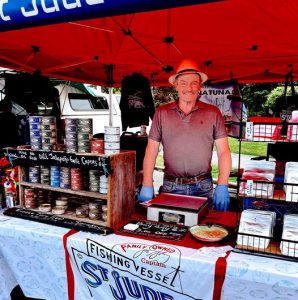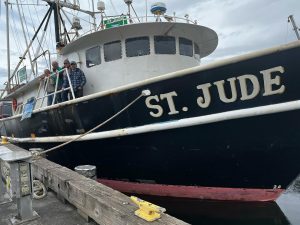October 28, 2024
By Jess Davis, WSG Science Communication Fellow

Joe Malley and St Jude sell a variety of tuna products they catch and can themselves. Photo courtesy of Joe Malley.
Prior to his life as a commercial albacore tuna fisher, Joe Malley was a graduate student and mathematics scholar teaching at the University of Oregon. The academic job market at the time left something to be desired. After the Vietnam War, student enrollment rates nationwide were dwindling. As Malley explains it, he realized that his prospects upon getting his PhD amounted to “getting a non-tenure track job at a no-name university or community college, probably in a place where nobody wanted to live.”
Sensing Malley’s ambivalence towards his future career, and knowing that he grew up an avid sports fisher, Malley’s girlfriend at the time suggested that he go on an outing with Gary, her brother-in-law. Gary was a fisherman targeting salmon out of Petersburg, Alaska. It was this trip upon Gary’s 38-foot boat The Stamper that altered the course of Malley’s life. It was “like a dream, really,” Malley recalls of the experience. “It was an experience that really every young man should have because it just opened my eyes.”
The natural beauty and freedom to be his own boss convinced him. Malley proceeded to sell everything he owned and borrowed all he could to purchase his first boat and commercial fishing permit out of Charleston, Oregon. He was ready to go – excluding the fact that his only experience as a captain was on a fourteen foot skiff with an 18 horsepower Johnson outboard on the transom. And that the only deckhand he hired, his roommate from graduate school, had never been on a boat before. “[We] had a lot of learning to do,” Malley says.
But after some initial hiccups, Malley found himself with enough experience to become a successful career fisher. He started out targeting salmon, then moved on to halibut, then black cod. He targeted the latter two species using a bottom long-lining technique. But the technique’s non-selectivity troubled Malley – having to throw back bycatch without knowing the fate of the fish he threw back.
Malley heard from a fishing colleague that the albacore tuna fishery did not suffer from bycatch issues, which Malley believed too good to be true. “Fishermen are always exaggerating,” he claims. It turns out, however, that it is true. Juvenile albacore tend to inhabit waters ranging from 14 to 16 degrees Celsius, which is outside the comfortable temperature range for many other marketable species that live throughout the Pacific Ocean. This, combined with the fact that fish who thrive in this temperature regime seem averse to the gear used to catch albacore, keeps their bycatch to an absolute minimum. In 30 years targeting albacore, Malley says, the only bycatch that made it past the boat barbecue was a pair of 20-inch baby thresher sharks that had tangled their tails in a jig leader and were released unharmed.
St. Jude, Malley’s family tuna company named after their fishing boat, is committed to sustainability, and reducing bycatch is one way they incorporate sustainability into their business model. Monterey Bay Aquarium’s Seafood Watch program, a leading source of information about sustainable seafood choices grounded in science, has partnered with St. Jude for offering “Best Choice” (i.e., most sustainable) products to consumers.

The Malley family aboard the St Jude. Photo courtesy of Joe Malley.
These days, Malley and his team at St. Jude are going a step further, prioritizing not only sustainability, but also quality. Each albacore landed by St. Jude is handled individually and with meticulous care. Once aboard, each fish is processed individually atop a cushioned platform to prevent bruising and then placed into an onboard blast freezer. This entire process is time controlled, which helps to ensure rapid freezing and maximum freshness.
St. Jude has also shifted their business in recent years to canning their catch themselves. The difference between St. Jude and other big-name canned tuna is the process the fish undergo from boat to can. Most canned tuna uses a hot packing method. This means that the tuna is steam cooked before being canned with flavor enhancers to produce the canned tuna most of us know. St. Jude uses a cold packing method, where raw fish and seasonings are placed into the can, sealed, and cooked inside of the can. Cold packing ensures that the tuna’s natural flavors and inherent health benefits are retained.
Though his path to commercial fishing was not direct, Malley is proud to own and operate The St. Jude. Without his sudden and unexpected career transition, he never would have met his wife and the co-owner of St. Jude, Joyce, and consumers would have one fewer option for responsibly-sourced tuna. Malley remains committed to sustainability so the family legacy can live on. All in all, I call that a win.
###
Washington Sea Grant, based at the University of Washington, helps people and marine life thrive through research, technical expertise and education supporting the responsible use and conservation of coastal ecosystems. Washington Sea Grant is one of 34 Sea Grant programs supported by the National Oceanic and Atmospheric Administration in coastal and Great Lakes states that encourage the wise stewardship of our marine resources through research, education, outreach and technology transfer.
Join the conversation: instagram.com/waseagrant and Facebook.com/WaSeaGrant.
OCT
2024